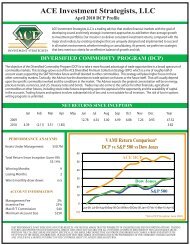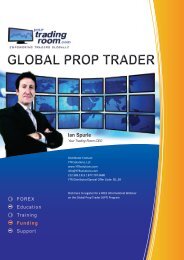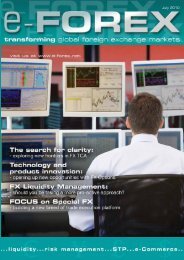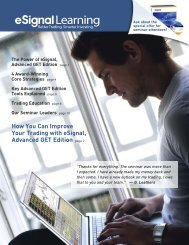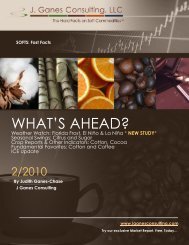Create successful ePaper yourself
Turn your PDF publications into a flip-book with our unique Google optimized e-Paper software.
ALGORITHMIC FX TRADING<br />
Giles Nelson<br />
“In FX it is more about achieving a weighted price than<br />
chopping an order into small parts.”<br />
not be<strong>com</strong>e an unhelpful variable in the execution.<br />
Multi-asset trading is still an emerging area,” says<br />
Nelson. “Many brokers are still very siloed when it<br />
<strong>com</strong>es to different asset classes, however we are seeing<br />
some of the barriers <strong>com</strong>ing down, particularly when it<br />
<strong>com</strong>es to equities and derivatives.”<br />
Second-mover advantage<br />
In many ways, the FX market is just following what<br />
has already taken off in other asset classes but this<br />
slower pace of development does have its benefits<br />
when it <strong>com</strong>es to implementing algorithmic trading<br />
tools – a kind of second –mover advantage, says<br />
Nelson. “Electronic trading has only really be<strong>com</strong>e<br />
popular in the last few years so this means that there<br />
are not the legacy systems that exist in equities. FX<br />
firms trading electronically and looking at adding<br />
algorithmic trading capability can adopt the latest<br />
technology and implement it much quicker.”<br />
Nelson points to the example of aggregation where<br />
multiple liquidity pools are displayed on one screen.<br />
“Aggregation is possible because there are these<br />
different venues that are all easily accessed through<br />
electronic trading. But in equities there are all of these<br />
different alternative venues like Turquoise and Chi-X<br />
which are all different. You may not get the same range<br />
of choice in FX but in aggregation terms, it has a more<br />
modern infrastructure and is a less <strong>com</strong>plex product.”<br />
While FX is undoubtedly a less <strong>com</strong>plex product, there<br />
are nonetheless drawbacks in applying algorithms to<br />
the emerging currencies which are far less liquid than<br />
78 | january 2010 e-FOREX<br />
>>><br />
their G7 counterparts. However, says Nelson, these<br />
obstacles can be over<strong>com</strong>e through the use of synthetic<br />
currency pairs. “For example, if you wanted to pair the<br />
Serbian dinar with the Brazilian real, you would be<br />
hard pressed to find a bank willing to arrange that<br />
currency pair. But if you were to trade both currencies<br />
against the dollar, you would then have two liquid<br />
trades rather than one illiquid trade and you simply tell<br />
the algorithm that it is a dinar/real trade. All of this can<br />
be done through new software and it makes it easier to<br />
get a good price for this currency pair.”<br />
What is beyond doubt, says Nelson, is that black box<br />
algorithms should be a thing of the past. “A lot of firms<br />
may start with a black box but eventually they will<br />
want to do something different and change the way<br />
their orders are traded. Being able to alter the<br />
algorithms is such an important feature. As the<br />
industry matures and be<strong>com</strong>es more accustomed to<br />
using algorithms, it will be easier to make money if you<br />
don’t have the same algorithms as everybody else. There<br />
are broker-supplied algorithms that traders may get for<br />
free and are easy to set up but they are the same as<br />
everyone else’s. You really need an algorithmic trading<br />
set up that enables you to create your own algorithms.”<br />
Work in progress<br />
Despite the great progress made in the development of<br />
FX algorithms, the majority that are used are still works<br />
in progress, says David Hastings, global head of FX sales<br />
at FlexTrade, a broker-neutral provider of algorithms for<br />
multiple asset classes. “There are still the two camps in<br />
terms of algo users – those who are using them to add<br />
alpha and those who are using them to trade more<br />
opportunistically. More recently we are seeing a greater<br />
interest in the latter, although overall we are not seeing<br />
any developments that are to dramatic.”<br />
The development of the algorithms is also dependant<br />
somewhat on how the various liquidity providers in the<br />
market have set themselves up, says Hastings,<br />
particularly if they have embraced aggregation rather<br />
than remaining opposed to the idea of consolidated<br />
displays of prices. “Some of the larger banks are more<br />
particular about how their flow is displayed. But<br />
ultimately the decision of whether to open the bank’s<br />
flow to aggregation will be driven by clients rather than<br />
the banks themselves. Eventually I think most banks<br />
will have to embrace aggregation.”<br />
One of the banks’ concerns with the rise of aggregated,<br />
electronic pricing is that customers will now be guided<br />
solely by price and will be unconcerned by the identity<br />
of the sell-side counterpart in a currency trade, thus<br />
threatening the ‘relationship’ aspect that has




